What to Expect During an ABA Evaluation
June 22, 2022
June 22, 2022

“My child has a diagnosis of autism spectrum disorder (ASD) … now what?”
If you’ve found yourself asking this question, you’ve come to the right place. Your child has already taken part in autism testing and received a diagnosis, but now you may be wondering what comes next.
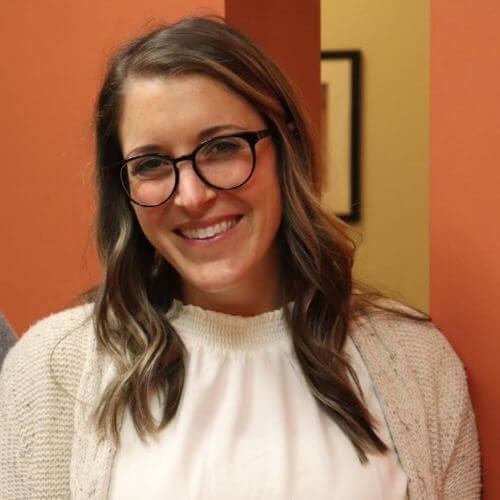
The diagnostician or pediatrician may have mentioned any number of autism services and opportunities available to your child, but what does that mean and how do you get started? It is likely that included in this list of services is applied behavior analysis (ABA therapy), which is the only evidence-based methodology proven to help children cope with the symptoms of autism that may be impeding on areas of their daily lives.
To start their ABA journey, your child will need an ABA evaluation. This is different from a diagnostic evaluation. We connected with Hopebridge Regional Board Certified Behavior Analysis (BCBA) Janelle Stawasz to walk you through the process at our centers. She gave us a detailed outline on what your family can expect, as well as some tips for making the assessment as smooth as possible for you and your kiddo.
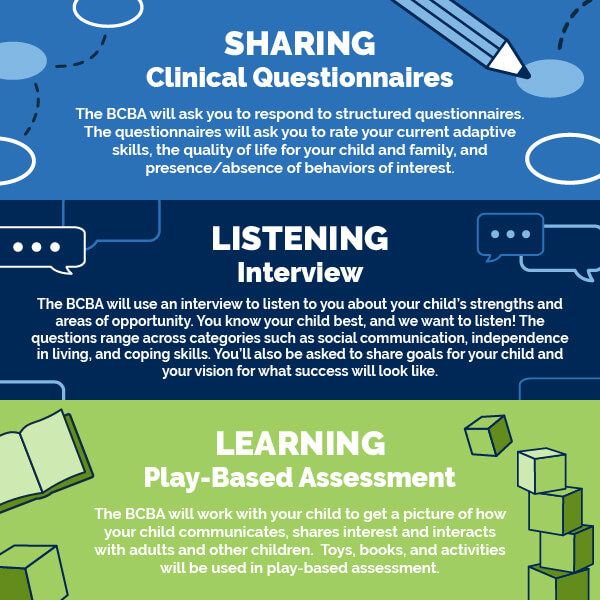
Preparing for the ABA evaluation begins with a Care Coordinator reaching out to schedule an appointment. Caregivers should plan to spend around two hours at the appointment. Hopebridge has interpreters available through LUNA Language Services, which we can arrange at this time if the family could benefit from their support during the evaluation. Working with interpreters can extend the length of the appointment, so parents should be prepared to spend extra time if they choose to use these services.
Some of the work for parents and guardians begins even before the in-person meeting. Within approximately two weeks of the appointment, caregivers will receive an email that outlines all of the documents required to start the ABA evaluation. This electronic patient paperwork gathers background information, insurance details, emergency contacts, etc., as well as lays out Hopebridge’s policies. These documents must be returned in advance of the appointment.
One of the biggest elements of the ABA evaluation is also sent at this time. The Vineland Adaptive Behavior Scales (VABS) (Vineland-3) is a standardized assessment tool for all of the initial ABA evaluations conducted by Hopebridge. Rather than solely providing a score, the Vineland provides an outline of the child’s strengths and deficits as it relates to the core domains of autism: communication, daily living skills, socialization, motor skills and behaviors. This helps the BCBA determine which skills and behaviors to prioritize for therapy.
We recommend parents set aside time dedicated to filling out the Vineland, which can be a pretty lengthy questionnaire. The assessment uses scales with responses like “never” and “sometimes” to questions asking about the child’s skills and behaviors. It can take around an hour to fill out, but there are ceilings, so if a certain number of “never” responses are used, for instance, the assessment could end in less time. Parents can fill out the Vineland on a computer, tablet or phone. We highly recommend doing this portion in advance, otherwise families will need to spend more time at the center on the day of the evaluation.
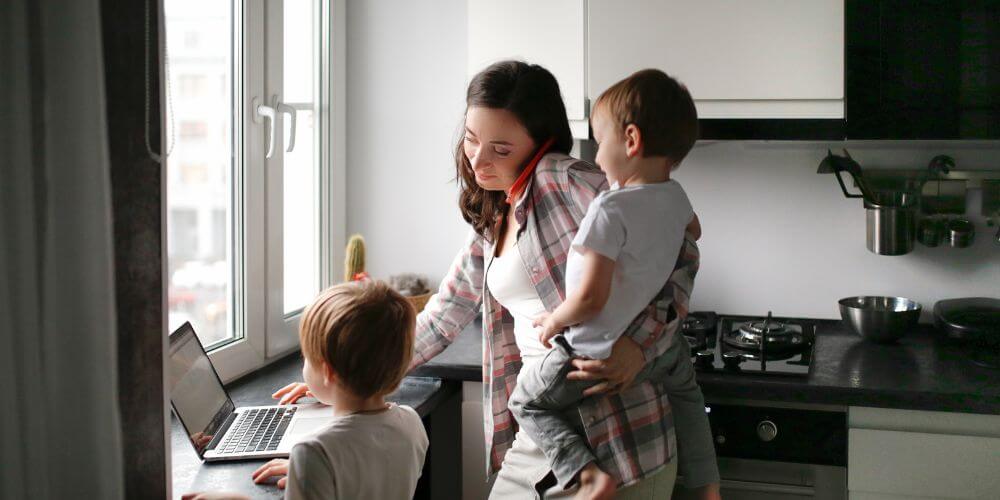
In addition to these documents and assessments, there are a few additional items or pieces of information that can be beneficial to prepare:
On the day of the ABA therapy evaluation, the child and parent will be greeted by a BCBA at the center. Because much of the initial evaluation is parent-reported, they may also have another therapist, a Registered Behavior Technician (RBT), with them to assess the child while the BCBA meets with the caregiver. It can sometimes be difficult for the parent to focus on the questions while the kiddos are in the room, so if the child is comfortable with it, the therapist can take them to the gym area or other room to play. Some children don’t want to leave their parents, however, so we also have toys available in the evaluation room for those scenarios.
To kick off the appointment, the BCBA typically introduces the parent to Hopebridge and applied behavior analysis. For instance, Janelle likes to talk about Hopebridge’s focuses on early intervention and transitions to school. She also covers topics like, “What is ABA?” and makes time for parent questions, of course.
“Some parents come in with a lot of questions or preconceived notions about ABA therapy after reading about it on Facebook groups, Instagram or other websites, so I like to talk through any concerns they may have, as well as share what the services are like in our centers,” said Janelle.
“I also use this time to reiterate our schedule, as some parents don’t realize comprehensive ABA is more than just a couple hours a week. I want to make sure we are all on the same page with the potential time commitment before the evaluation.”
Once the introductions have taken place, the BCBA will guide parents through several in-person questionnaires that cover everything from background information, to medications, to former schools and therapy providers. This is where that pre-evaluation preparation comes in handy!
Next, the BCBA will gather details on the child’s behaviors and very specific information about what those behaviors look like through a Functional Behavior Assessment (FBA). For example, does the child engage in aggression, and if so, what exactly does it look like, how often does it occur, where does it occur, with whom does it occur, etc.? The intent is to determine why the behavior is occurring and develop an intervention plan to help the family reduce those behaviors moving forward.
The BCBA will also fill out a reinforcement profile with the parents to learn what the child likes and dislikes. They can use this information to make a plan to build onto their preferred items and desensitize things they find aversive, such as loud noises.
As the BCBA goes through these pieces of the evaluation, they will also refer to the Vineland. If completed in advance, they will review the results, otherwise they’ll have the parent fill it out in the center.
Up until now, the evaluation is standardized between Hopebridge locations, but sometimes the BCBA will also choose to implement additional assessments.
In some cases, while the BCBA is managing the parent-reporting portion of the evaluation, the RBT will simultaneously conduct the Behavioral Language Assessment Form (BLAF) with the child. This is a 12-question preliminary assessment that is typically used ahead of a more comprehensive assessment that will be conducted at a later time. If another therapist is not present, the BCBA will coordinate the BLAF after meeting with the parent.
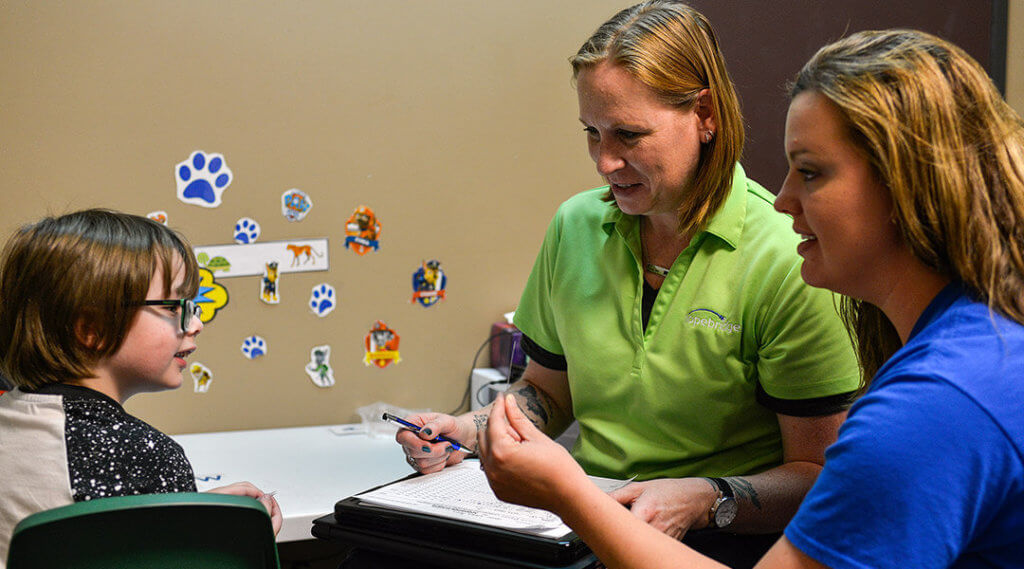
The BLAF uses play-based activities to learn more about the child. For instance, they might see if the child will imitate actions—if the RBT “drives” the toy car, will the child also drive their toy car?
“We know that a two-hour time span won’t allow us to observe all of the child’s skills, nor will they witness some of the maladaptive behaviors that occur at home. We are new to them and understand we won’t get the full picture in one sitting, which is why we rely on parents’ notes for much of the first report,” said Janelle.
The BCBA or an assisting Fellow could begin a skill-based assessment with the child, but they may also choose to wait as it is pretty thorough and takes six to eight hours to assess. Either way, if the child starts services, the therapy team will update the report with the completed skill-based assessment within the first 30 days.
The ABA evaluation usually ends with a tour of the facility to give the caregivers an idea of what it’s like to spend a day with Hopebridge.
Once the Vineland and other surveys are completed, the BCBA will use them to make their recommendation. About 90 percent of the time, the behavior analyst is able to share their recommendation of hours during the appointment. If not reported that day, they will call back to let the parent know their recommendation.
It’s important to note that participating in an evaluation does not guarantee participation in ABA services at Hopebridge, but rather helps determine whether ABA therapy is a good fit for the child, and if so, what that might look like..
There are a few different routes the evaluation could take the family on, which include:
If the BCBA’s clinical recommendation does lead to therapy at Hopebridge, they will also recommend a certain number of hours of therapy and formulate goals they think would be appropriate for the child.
The suggestion of hours could be full-time, center-based therapy at 35 hours, focused at 20 hours, or somewhere in between. Other times, the BCBA could recommend that in-home autism therapy is more suitable for the child.
Janelle notes that the Hopebridge team understands that sending your child outside of the home for 35 hours a week can feel overwhelming at first, but she urges parents to open their minds to what it can do for their child. Outcome measures for children who participate in early intensive behavioral interventions are significantly higher than those who attend part-time or wait until they are older to receive ABA services.
“That recommendation of hours may be unexpected for some parents who do not want to be away from their children all day, so we can sometimes arrange for them to ease into it,” said Janelle. “That amount of hours is what we are recommending as medically necessary, but taking a few weeks or months to get to that point is better than limiting or skipping ABA altogether.”
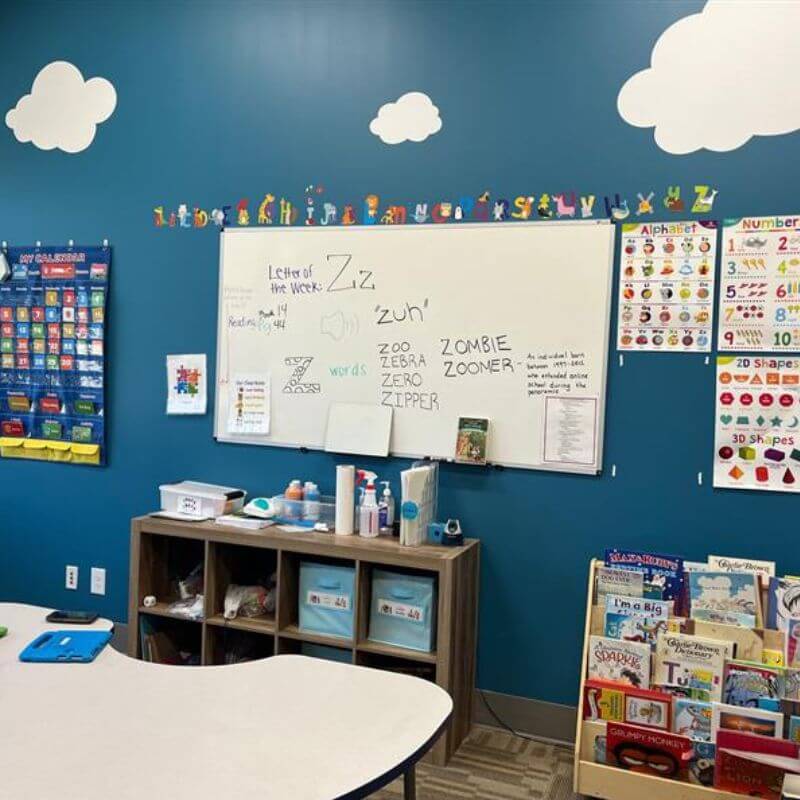
Parent training is a crucial aspect of ABA therapy, so the evaluation covers parent training goals, too. The BCBA will ask about the family’s biggest barriers and top priorities, which could be anything from toileting, to successfully administering medicine, to behavior reduction.
“I worked with a parent who was working from home and wanted to find out what her son wanted to watch on TV so she could entertain him while she was on the job. It was taking her 30 minutes to turn on each TV show and attempt to figure out whether he liked it. For them, our parent training goal was as simple as giving him a way to communicate his preferences, which saved her time while trying to work,” said Janelle.
After the evaluation, BCBAs write up the plan and send it to insurance within three to five days. From there, the next steps can vary depending on the child’s needs and the family’s location.
Availability at the local Hopebridge center – which can range from one week to a few months, depending on the current caseload and demand in the area – will help determine the start date for services. Once Hopebridge receives approval from the insurance company, we can plan the start date, of which a Care Coordinator or center manager will reach out to confirm.
The evaluation is important to identify the child’s strengths, skills, deficits and behaviors to be targeted for reduction. The BCBA will analyze the information from the parent, the assessments and additional paperwork and records provided to determine if ABA therapy would be medically necessary for the child at this time, and whether ABA therapy at Hopebridge is the best fit for them.
The ABA evaluation is a great opportunity to get to know more about you and your child so we can create the proper goals, and there will be even more chances to learn the needs of your family throughout therapy.
If therapy is recommended, the results of the evaluation will guide the BCBA to develop an appropriate treatment plan and submit to insurance for authorization, including the number of hours that are medically necessary for the child. From there, the insurance company will review the treatment plan and supporting documentation to determine the number of hours authorized for services.
“It’s essential to get a baseline of the child’s skills to submit to insurance for authorization,” said Janelle. “They look at it like a prescription for therapy, so we use the evaluation as a tool to tell insurance providers, ‘This is the number of hours of therapy we believe is medically necessary for this child.’”
it’s not uncommon for insurance providers to reduce the hours they will cover.”
While insurance approval is expected in most cases, in the instances that the insurance company denies coverage for therapy, Hopebridge can provide insurance support through peer-to-peer calls to explain why it’s necessary for the child.
At Hopebridge, our goal is to provide access to quality autism services for all families in need so their children have the opportunities they deserve to lead their best lives. In line with this vision, our evaluation is intended to be as easy as possible for children and their parents, while setting them up for a bright future. If you are ready to schedule an ABA evaluation – or if you are in the earlier stages and believe your child should be tested for autism – contact us now.
*Informed consent was obtained from the participants in this article. This information should not be captured and reused without express permission from Hopebridge, LLC.
Parenting Resources
December 21, 2020
What I Wish I Could Tell Others When My Child is Having a "Meltdown"
Autism Therapy
January 24, 2022
What the Increased Prevalence of Autism in Children Means for Your Family
Hopebridge in the News
May 30, 2019
Hopebridge Expands Across Atlanta with Five Additional Pediatric Autism Therapy Centers